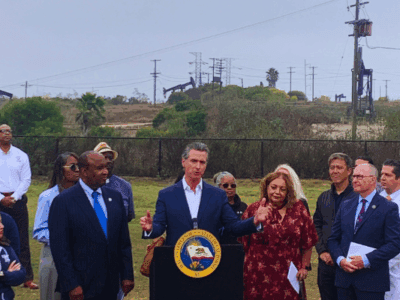The Unintended Consequences of Rapanos
In the Rapanos case, building on its previous ruling in SWANCC, the Supreme Court cut back on federal jurisdiction over water bodies. The issue before it was the government’s power to control filling of isolated wetlands, and it seems clear that the Court was solely focused on what it considered an inappropriate expansion of federal authority over land use. But the same jurisdictional language in the statute applies to pollution. As a result, the NY Times reports today, the EPA has had increasing difficulty in controlling water pollution:
About 117 million Americans get their drinking water from sources fed by waters that are vulnerable to exclusion from the Clean Water Act, according to E.P.A. reports….
[M]idlevel E.P.A. officials said that internal studies indicated that as many as 45 percent of major polluters might be either outside regulatory reach or in areas where proving jurisdiction is overwhelmingly difficult.
And even in situations in which regulators believe they still have jurisdiction, companies have delayed cases for years by arguing that the ambiguity precludes prosecution. In some instances, regulators have simply dropped enforcement actions.
According to the Times, efforts to restore the previous coverage of the Clean Water Act have been blocked by conservatives and farm interests. The Clean Water Act was in effect for many years before the Supreme Court’s conservative majority applied the pruning shears. Yet the sky didn’t fall, and federal bureaucrats didn’t prosecute farmers for filling in mud puddles. It’s time for Congress to undo the mischief of the Court’s ruling.
Reader Comments
4 Replies to “The Unintended Consequences of Rapanos”
Comments are closed.







Over the years, the EPA and Corps of Engineers have expanded federal CWA jurisdiction to the point where almost all land development projects must be approved by the federal government. Traditionally, land development was regulated at the state and local level because this was one of the powers reserved to the states under our constitution.
The discharge of a pollutant from a point source into waters of the United States is still regulated by the EPA. The Supreme Court in its Rapanos and SWANCC decisions restricted federal regulations covering the placement of fill material (dirt, gravel, rock, concrete) into isolated wetlands and other isolated, intrastate waters.
States retain the power to regulate such activities and many States have regulatory programs in place. The problem with CWA jurisdiction is constitutional conflicts that arise when the federal government intrudes on State’s rights.
Dan —
I’m disappointed you’re so quick to endorse the NYT’s parrotting of EPA’s sob story on this one. The EPA was first put on notice that it’s regulatory definition of waters were overly expansive some 15 years ago. Richard Lazarus and I (hardly ideological soulmates) pointed this out in our respective writings on the issue. And yet the EPA (and Corps) ignored any concerns with their regs and proceeded with regulation as usual.
After SWANCC, the EPA and Corps were left with ample room to develop ecologically sound criteria for establishing jurisdiction that were consonant with the statutory text and the Court’s federalism concerns, and yet the agencies did nothing. Rapanos was the logical end result.
With Rapanos, once again the agencies were told their regs were too expansive. And, once again, the agencies were left with ample room to develop new regulations that provided a sounder ecological and legal basis for the assertion of jurisdiciton. Indeed, three separate opinions in Rapanos explicitly noted that the agency could provide greater regulatory certainty and jurisdictional coverage if it would engage in a new rule-making. Even the Scalia plurality adopts a Chevron Step II analysis, leaving the agency ample room to adopt a reasonable interpretation of the ambiguous statutory text.
The bottom line is that the agencies have had ample basis to reassert broad regulatory jurisdiction and virtually eliminate the need for onerous case-by-case jurisdictional determinations, but they’ve refused to act. (They considered acting in the early Bush Administration, but enviros cried foul.) The CWRA is no solution. Even assuming its constitutionality, the language of that law is so expansive it will still require implementing regs to create the desired degree of certainty and predictability.
I’ve discussed this at length in my various articles on wetlands regulation, SWANCC, and Rapanos, and my testimony on the CWRA. Much of this is summarized in this article I wrote for Regulation:
http://www.cato.org/pubs/regulation/regv32n4/v32n4-5.pdf
Regards,
JHA
Justice Scalia’s understanding of the CWA’s use of the term “point source” as an important factor in making the determination that, only those Wetlands with a continuous surface connection to bodies that are waters of the Untied States are included as waters of the United States seems misguided and incorrect. The CWA uses the term point source to limit the possible universe of SOURCES of pollution that would be subject to regulation under the Act, not the types of subsequent conveyances that could transport these discharges to “waters of the United States”. The CWA states that a point source is a specifically defined or discrete conveyance “from which pollutants are or may be discharged” 33 USC 1362(14)). Congress did not want to extend regulation to contaminated rainwater flows from parking lots, roadways, and other unintentional discharges from facilities even though these discharges pose a huge threat to our nations waters. It chose to do so by only regulating discrete points where discharges might occur and defining these in terms the types of conveyances which may create these points of discharge. It is the conveyance that creats a discrete point of dishcarge at which pollution control could occur.